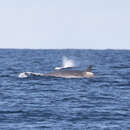External Morphology
provided by EOL authors
Head Shape Melon is well defined, relatively steep, more so than most Mesoplodon species, about the same as Ziphius and less so than both Hyperoodon and Berardius species. Long beak is well differentiated from the melon and is more slender at its tip than other ziphiids. Jawline is weakly sinusoidal. Coloration Dark dorsally and light ventrally with a faintly visible light patch on the anterior surface of the head. There is a light patch just anterodorsal to the flippers that appears to be continuous with the light patch on the belly. An additional pair of elongate light patches exists on the sides running posteroventrally from just behind the flipper to the caudal peduncle. Size Adult body length ranges from 6 -7 m. Recorded maximum body length for adult males and females is 7.0 m and 6.6 m, respectively. Body length at birth is 3 m. Most Likely Confused With: Berardius arnuxii Hyperoodon planifrons Indopacetus pacificus
External morphology
provided by EOL authors
Head Shape Melon is well defined, relatively steep, more so than most Mesoplodon species, about the same as Ziphius and less so than both Hyperoodon and Berardius species. Long beak is well differentiated from the melon and is more slender at its tip than other ziphiids. Jawline is weakly sinusoidal. Coloration Dark dorsally and light ventrally with a faintly visible light patch on the anterior surface of the head. There is a light patch just anterodorsal to the flippers that appears to be continuous with the light patch on the belly. An additional pair of elongate light patches exists on the sides running posteroventrally from just behind the flipper to the caudal peduncle. Size Adult body length ranges from 6 -7 m. Recorded maximum body length for adult males and females is 7.0 m and 6.6 m, respectively. Body length at birth is 3 m. Most Likely Confused With: Berardius arnuxii Hyperoodon planifrons Indopacetus pacificus
- license
- cc-by-3.0
- copyright
- Smithsonian National Museum of Natural History Marine Mammals Program
Skull morphology
provided by EOL authors
Diagnostic features of the skull and mandible On the vertex of the dorsal skull the premaxillary bone extends forward of the nasal and frontal bones. Separates from Berardius and Ziphius. No sulcus exists in middle if the combined antero-dorsal surface of the nasals. Separates from Mesoplodon and Hyperoodon. The area of the synvertex of the skull occupied by the nasal bones far exceeds that occupied by the frontals. Separates from Indopacetus. There are between 17 to 27 pairs of rooted teeth in both the mandible and maxilla. Separates from Berardius, Hyperoodon, Indopacetus, and Mesoplodon.
- license
- cc-by-3.0
- copyright
- Smithsonian National Museum of Natural History Marine Mammal Project
Tooth morphology
provided by EOL authors
Tooth position Tasmacetus shepherdi is the only member of Ziphiidae that has functional tooth rows in the maxilla and mandible. These teeth have bulbous roots that sit upon platforms of spongiform bone in shallow alveoli. There are between 17 to 27 pairs of erupted teeth in both upper and lower jaws of males and females. Tooth exposure A larger anterior pair of mandibular teeth erupts in males, but not in females. These teeth are located at the apex of the mandible. The non-apical teeth erupt above the gumline in both males and females. Tooth shape These teeth are somewhat conical with an enlarged base that varyingly produces an asymmetric pear shape. The lateral profile of tooth is convex proximally, then concave and straight distally. Greatest length for adult male apical teeth is 41 mm, greatest antero-posterior diameter 24 mm, and greatest transverse diameter 16 mm.
- license
- cc-by-3.0
- copyright
- Smithsonian National Museum of Natural History Marine Mammal Project

